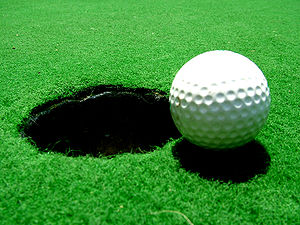
- Image via Wikipedia
The summer before the 1964 World’s Fair, the leaders of New York City broke ground in Flushing Meadows, Queens, for the fair’s Hall of Science. Paul R. Screvane, the acting mayor and president of the City Council, predicted that the pavilion and its “wonders of science” would remain an inspiration long after the fair ended.
“The grandeur of Rome and Greece can be the grandeur of our own world,” he said, “if only we learn to turn the sciences to our own advantage.”
Half a century later, his dream is about to be fulfilled next to that very building, which is now a science museum. On Saturday, a permanent outdoor exhibition will open: Rocket Park Mini Golf.
The Hall of Science’s miniature golf course may not have quite the architectural grandeur of the Parthenon, but it has real NASA rockets three times as high as the Greek columns, and in some ways its aspirations are more heroic than anything at the Forum.
This is believed to be the world’s first mini-golf course designed to teach astrophysics. Possibly even to tweens.
Better science through mini-golf may not immediately sound like an educational breakthrough, but there are a couple of reasons for optimism. First, there’s the native genius for this sport. While American students keep getting outscored in international science tests, American mini-golf designers have long led the world in technologies like windmill obstacles, loop-de-loops, moving drawbridges, laughing pirates and steaming volcanoes.
Second, there are the results of an experiment on mini-golfing fourth graders that I conducted with an astrophysicist, Michael Shara of the American Museum of Natural History. When he is not curating exhibitions or using the Hubble telescope to study nova explosions, Dr. Shara is a 30-handicap golfer.
With his help, I drew up a quiz to test the fourth graders’ physics knowledge before and after playing the course. This comparison of “formative” versus “summative” assessments is a standard technique for museum curators to gauge an exhibition’s impact, although I should note that ours was not a rigorous double-blind experiment. Our sample size was two, and I had a pretty good idea who both of them were: my son, Luke, and his friend Satya Varadarajan.
On the pre-golf quiz, both got most answers wrong. Asked to explain the weightlessness of orbiting astronauts, they incorrectly said that astronauts were too far from Earth to be affected by its gravity. When asked why Earth’s gravity didn’t cause an orbiting spaceship to fall to the ground, Luke said he didn’t know, and Satya offered an unorthodox hypothesis.
“Gravity,” he explained, “doesn’t want the spaceship to fall down, so he doesn’t let it.”
They seemed prime candidates for the Rocket Park course, which is named for the 10-story Atlas and Titan rockets that have been standing outside the Hall of Science since the 1964 fair. Guided by museum docents (another mini-golf first), you start your nine-hole mission by putting the ball through a “launch window” (a version of the old windmill hazard) and achieving the proper “escape velocity.” Then you send the ball around a loop-de-loop and learn all about weightless astronauts, after which you learn about avoiding debris in space and finding the right angle for geosynchronous orbit — or at least you learn these things if you’re reading the signs next to the tees and listening to the docent, as Dr. Shara and I were doing along with the museum’s director and chief content officer, Eric Siegel.
![Reblog this post [with Zemanta]](http://img.zemanta.com/reblog_b.png?x-id=13eb0612-4f6c-41e3-a7a7-064f0a5c46e9)








